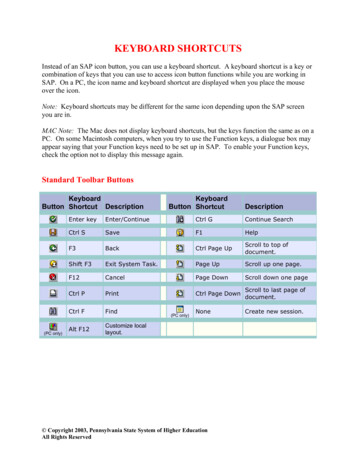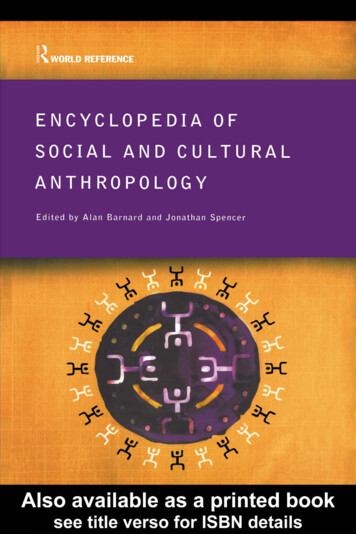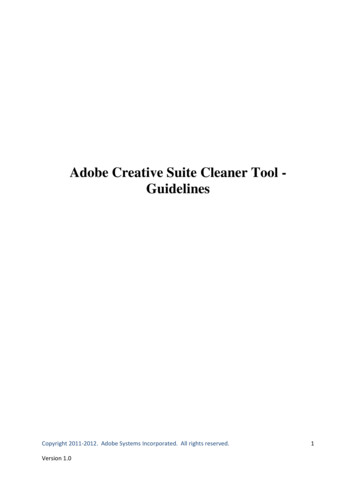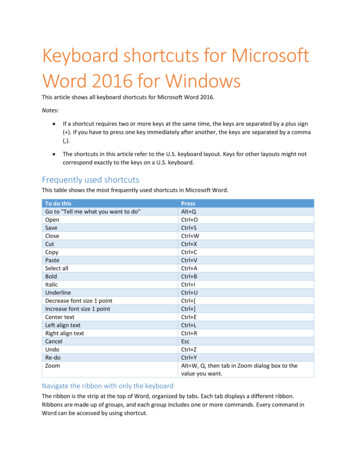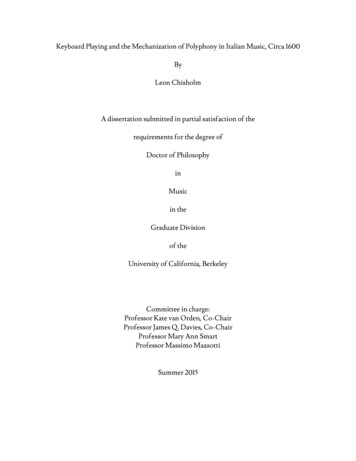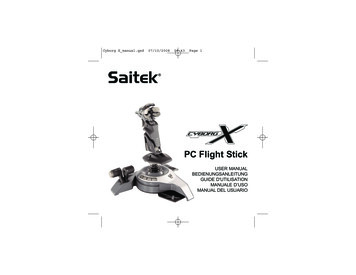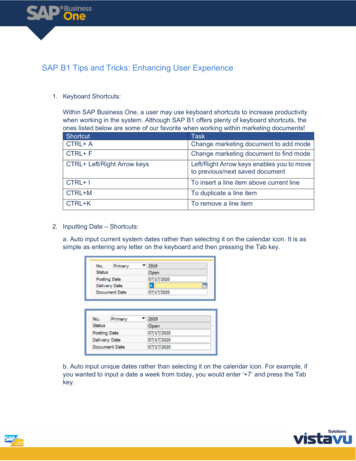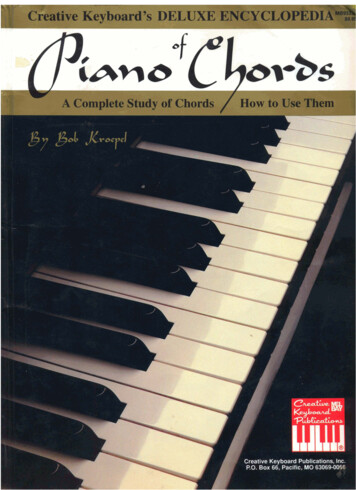
Transcription
I1Creative Keyboard's DELUXE ENCYCLOPEDIA-A Complete Study of Chords/How to Use Them
Creative Keyboard'sDELUXE ENCYCLOPEDIAOFPIANO CHORDSA Complete Study of Chords and How to Use ThemThe Deluxe Encyclopedia of Piano Chords is a complete and thorough analysis of chords asapplied to the piano keyboard. This study encompasses chord construction, usage, scales and rhythmpatterns.It is hoped that this text will enable the pianist or organist to effectively use and apply the fulldiversity of chord possibilities in creating interesting, personal and colorful musical styles.Dedication: To my Mother, Mabel M.,and my Father, Elmer H. Kroepel;music was a happiness in our home.Bob Kroepel0 1973 by Mel Bay Publications, Inc., Pacific, MO 63069.All Rights Reserved. International Copyright Secured. B.M.I. Made and Printed in the U.S.A.
Piano Keyboard Diagram.IntervalsHalf-Step and Whole-StepThirteenth ChordThirteenth Flatted Ninth ChordSeven Six ChordSix Nine Chord . 19.AccidentalsChart of Accidentals .Enharmonic Notation. 20Numbering the Fingers . 22Major ScabsScab Degrees .Explanotion of the KeyboardDiagrams and Annotation . 23ChordsChord-Tones .25Inversions .Key of C Major. Scales and ChordsConstruction of Common ChordsMinor TriadMajor TriadAugmented TriadLowered Fifth Triad .Key of Ob Major (Identical to C#Maior) Scales and Chords . 30Key of D Major. Scales and Chords . 35Key of Eb Major. Scales and Chords . 40Diminished TriadMaior Seventh ChordDominant Seventh ChordMinor Seventh Chord .Maior Sixth ChordMinor Sixth ChordDiminished Seventh ChordMinor Seventh Lowered Fifth ChordKey of E Maior. Scales and Chords . 45Key of F Major. Scales and Chords . 50Key of F# Major (Identical to GbMajor). Scales and Chords . 55Key of G Major. Scales and Chords . 60.Seventh Augmented Fifih ChordSeventh Lowered Fifth ChordSeventh Suspended Fourth ChordMajor Seventh Flatted Third. FlattedFifth Chord .Key of Ab Major. Scales and ChordsKey of A Major. Scales and Chords . 70Key of Bb Major. Scales and Chords . 75.Mojor Seventh Flatted Third.Augmented Fifth ChordMajor Ninth ChordNinth ChordNinth Augmented Fihh Chord . 16Ninth Lowered Fifth ChordMinor -Ninth ChordMinor Ninth Augmented Fifth ChordMinor Ninth Lowered Fifth Chord . 17Seventh Flatted Ninth ChordEleventh ChordEleventh Flatted Ninth ChordEleventh Augmented Fifth Chord. 65. 18Key of B Maior (Identical to CbMaior). Scales and Chords . 80. 85Using Chords to Play Popular Music . 87Range of the Bass. Chords and Melody.89The Fox Trot Rhythm Pattern . 91Alternating the Bars .94Using Different Chord Positions . 95The Waltz Rhythm PatternAlternating the Alternoting Barsbl. Mel B q hbliutlonr, k.ratmntionrl Copyfight Sd.Priatd ia USA. -:-All Wtr W.Q*ri&t1973ltfrhood N o. 96
Here is a keyboard diagram showing the white keys of the piano keyboard and their location on theGrand Staff:TrademarkNotice that the number of leger lines needed to locate the pitches of the piano on the Grand Staflincrease towards the ends of the keyboard.To make it easier to read music is often written with the symbol 8va instead ot the exact number ofleger lines.8 means1"octaver "Octave" comes from theLatin word "octava: meaning "eighth: An octave is thesame letter eight letters to the left o r right of the original:A B C D E F C A B C D E F GA B C D E F c A BC.-*.-.T' octaveTToctaveoriginal8va written above a note means to play the note with the same letter name an octave higher:Writ ten:Played:IF8va8va a b s o means to play the note with the same letter name an octave lower:Written:Played:8va a baeeo!8- means two octaves higher: 2 8va a bo means two octaves lower.OCoprtifit I973 by %el 8.1 hbliatiwr, InC.Kirkwood. Mo. -:-b u m t i o d CopyrWt Sccwd.P t i d ia USA. -:-NlR d .
In music an Interval is defined a s the distance (in terms of pitch) between two notes.The smallest interval on the piano keyboard is the klf-etep: a half -step is defined a s the intern1between two adjoining notes :-halfstephalf-stephalf-S*PTwo half- steps equal one whole-atep:whob-wholestepstepwholestep
Musical symbols which alter the letter names of notes are called aceidentala.Here is a chart which explains the symbols used for accidentals:ISymbol#bNameF u nc tionSharpraises pitcha half-stepFlatlowers pitcha half-stepX!Double*Sharpraises pitch twohalf- s teps, orone whole- stepbbDOUM.-FI lowers pitch twohalf-ste s orone who e- stepExample1PNaturalcancels a sharpor a flat-.
Major Scales.-----The musical alphabet is a continuum, repeating endtessly the first: sevt?fi letters of the Englishlanguage alphabet:ABCDEFCABCDEFCABCDEFCA. usetc,A scale is a series of tones in an organized sequence.A major acole is an eight-letter sequence of the musica1"aIpHrbet The first letter of the major scale is called the Qnic wt., or bymte: the last letter of the miorscale is the same as the keynote but is called the O C W .Ex. C major wale-CDIEFC--A-BKeynote--CI .OctaveThe tones of the major scale can be numbered:The numbrs referring to the tones of a major scale are called ecale degree@.The musical relationships between the tonea of a major ecale can be expressed by means of wholeateps(abbreviated W) and haif-atepa (abbreviated H) :CDEFCABCHere is the C major scale shown on a keyboard diagram:Cmaiorscale-CScale degrees-D E F C A B Cl l l l l l l i1. 2 3. 4. 5. 6. 7. 8.
To preserve the whole-step and half-step relationships between the tones of a major scale thekey signatureindicates which notes are sharped or flattedEx. The G major scaleThe F sharp(F#) in the key signature indicatesthat this note is to be played F sharp(F# )lllll bC major scale-CScale degrees-1. 2. 3. 4. 5. 6. 7. 8.1A 0 C111D111# Cl)Ex. The F major ecaleThe B flat(Bb) in the key signature indicatesthat this note is to be played B flat(Bb)F major scale- F GScale degrees-A Bb C D E F
A chord is defied as two or more notes played at the same time. In popular music a chord generallyhas a minimum of three notes.The pitches which make up a chord are called chord-tones:any other pitches are called non-chordtones.Chords can be related to major scales by means of scale degrees.The chord-tone upon which the rest of the chord is built is called the root.The chord-tones of any chord can be related to the scale degrees of the major scale having the samekeynote as the root of the chord.Scale degrees-1.23.4.5.6.7.IKeynoteOctaveIbChord- tones- R.IRoot0.23.4.5.6.7.8.NOTE: R is used to differentiate cleerly the root of the chordfrom the keynote of the scale when using numbers.A major triad consists of the root, third and fifth scale degrees (R 3. 5.).C major scale- CDEFCABCScale degrees-1.23.4.5.6.7.aChord- tones-R.5.3.ECCA minor triad consists of the root, flatted third and fifth scale degreds (R. b3. 5.).Ex. C minor triadC major scale-C.D.E.F.C.A.B.C.Scale degrees-1.23.4.5.6.7.8.Chord- tones-R.b3.5.
InversionsA rearrangement of chord-tones is called an invereion.A chord with the root a s the lowest note is said to be in root position;a chord with the third a s the lowest note is said to be in the first inversion;a chord with the fifth a s the lowest note is said to be in the second inversion, etc.However, the term position is often used instead of inversion:the relationship between position andhvereion can be confusing and is shown below:Ex. C major triad.CC- RootRoot PositionIE-3rdC-5thFirst lrvereionorSecond PoeitionSecond InversionorThird Posit ionSice chord-tones can be rearranged into a s many positions a s there are chord-tones four-notechords will have four positions, five-note chords will have five positions, etc.Specific chord positions can be indicated by using a slash mark ( / ) after the chord symbol and a1etter,I" "for root position,or a number for other positions:C/R -- C major triad, root position; C/2C/3 -- C major triad, third position, etc.-Cmajor triad, second position;When the composer wishes to specify a particular bass note he may use a slash mark and a letterindicating the desired bass note:C/E -- C major triad(any position), E bass note; C/C-C major triad, C bass note, etc.A specific chord position and a specific bass note can be indicated by using two slash marks, theletter or number after the first slash mark indicating the chord position, the letter after the secondnrark indicating the bass note:C12/G-C major triad, second position, C bass note, etc.
Since it is difficult for the average-sized hand to play more than four notes at a time only the topfour notes of ninth(5-note) chords, eleventh(6-note) and thirteenth(7-note) chords will be inverted:Ninth ChordsEleventh chordsThirteenth ChordsNOTE:ninth, eleventh and thirteenth chords are substitutes for common o r dominant seventh chords;to simplify his playing the student may use the common or dominant seventh chord instead ofthe ninth, eleventh or thirteenth.
On the following pages chords and their construction by means of scale degrees are shownAlthough the examples given are for C chords any root can be used.The most common chord symbols will also be given.For the examples in C thb C major scale should be kept in mind:Cmajorscsle-Crlr rD E F G A B C D E F CrA B C1 1 1 1 1 1 1 1 1 1 1 1 1 1 1Scale degrees- L z 3. 4.s.6. 7. 8. 9. 10. 11. 12 13. 14. 15. rrt
Major TriadChord- tones-R.3.5.Chord symbol- C (capital letter only)Minor TriadChord- tones- R.b3.5.Chord symbols Cmor C-Augmented TriadChord- tones-R.,Chord symbols-C s,453.C ,Lowered Fiftb TriadChord- tones- R., 3. b5.Chord symbols- C-5, C(b5)C ( t 5)
Diminished TriadChord- tones-. R., b3., b5.Chord symbols-Cdim. C*Major Seventh Chord3.Chord-tones--R.,C h o r d symbols-Cmaj.7,CEG5.7.CM7.BDominant Seventh ChordC h o r d - t o n e s - R., 3., 5. b7.C h o r d symbol -C7Minor Seventh ChonlChord-tones-R., b3., 5. b7.C h o r d symbol Cm7C
Major Sixth ChordChord-tones- R.,3.5.6.Chord symbol- C6Minor Sixth ChordChord-tones-R., b3.,5., 6.Chord symbol-Cm6Diminished Seventh ChordChord-tones-R.,b3. b5.bb7.Chord symbol-Cdim. 7CEbGb BbbMinor Seventh Lowered Fifth Chord, or Half-Diminished ChordChord-tones- R.,b3.,Chord symbols -Cm7-5, C'b5., b7.
Seventh Augmented Fifth Chord, or Augmented Seventh Chord-Chord symbols C7 5. C7aug. 5Seventh Lowered Fifth CbordChord- tones- R., 3. b5. b7Chord symbols- C7-5, C7b5, C7(bS)Seventh Suspended Fourth ChordChord symbol C7sus. 4Major Seventh Flatted Third, Flatted Fifth ChordChord-tones- R.b3.,b5., 7.b3Chord symbols- CM7 bsCmaj.7, b3. b5
Major Seventh Flatted Third, Augmented Fifth Chord-Chord- t o n e s R., b3., 5. 7.Chord symbols-- CM7Cmaj. 7. b3,Major Ninth ChordChord- t o n e s - R. 3. 5. 7. 9Chord symbol-Cmaj. 9Ninth ChordC h o r d - t o n e s - R. 3., 5. b7. 9.Chord symbol- C9Ninth Augmented F i f t h ChordChord- tones- R., 3. t5. b7. 9.C h o r d s y m b o l s C9. 5.C9, 5. 5
Ninth Lowered Fifth ChordChord- tones R. B., b5. b7.9.Cflord symbt.rls CO-5, C:O, b5.Mioor Ninth ChordChord- tones H. b3. 5., b i . , 9.Chord symbol-CrilVMinor Ninth Augmented Fifth ChordChord-torics- R.,b3. 4.5,Chord symbols-b7. 0.Ctnsf5, Cm9 5Minor N i n t h Lowered F i f t h ChordCliord-tancXs- R,.b:l. b5. b?.,!).Chord symbols -LnlY-;,CEb(;blibI.)(.ln9, b5.
Seventh Flatted Ninth ChordChord- tones R., 3., 5.,b7., b9.Chord symbols C7, b9, C7-9Eleventh ChordChord-tones .,3.,5.,b7.,9.,11.Chord symbol C11CEGBbDFEleventh Flatted Ninth ChordChord- tones H.,3., 5. b7. b9., 11.Chord symbols-C11. b9. C11-9Eleventh Augmented F i f t h ChordChord symbols-CI1,P5,Cll. 5.
Thirteenth ChordChord-tones R.,3.,5., b7.,9., ll.,13.Chord symbol- C13.Thirteenth Flatted Ninth ChordChord-tones- R., 3., S.b7.b9., 11. 13.Chord symbols C13, b 9 ,C13-9Seven S i x ChordChord- tones-R., 3., S.,6. b7.Chord symbols C7,6, C7/6.S i x Nine ChordChord- tones -- R. 3. S., 6., 9.Chord symbol -C6,9.
Ehharmonic NotationThe musical alphabet is used to label the white keys only. The black keys derive their names fromthe adjjcent white keys.The following chart shows how the keys are named:C D E F C A B C D E F G A B CF b ElCb B#Notice that a black key can b v e two names, such a s C -Db. The fact that a key can have morethan one name is called enharmonic notation, meaning equivalent names for the same pitch.Notice that certain white keys can have two names, such as E-Fb. Enharmonic notation is used topreserve certain musical relationships, such as the whole-step and half-step relationships betweenthe scale degrees of a major ocale.Ex.M Major Scale.Ft major scale- F Scale degrees -- 1-Half stepFormula forMajor Scalesc#A BCl\I- \W /\i\/"\wHwI\/\WE8DlWF#1HBecause there must be a half-step between the 7 th and 8thscale degrees the white key which is a half-step down fromFI is now called Et insteul of F natural.
Enharmonic notation is quite often used in writing music in order to make it easier to read in certainsituations.In a diminished seventh chord the diminished seventh itself is theoretically written a s the double-flattedseventh scale degree ( bb7 ) : however, the double-flatted seventh is often difficult to read and theenharmonic equivalent, the major sixth scale degree, is often used instead:Ex. C Diminished Seventh ChordChord- tones R., b3., bS., bb7C dim 7CEbGbtheoret'icalnotationBbb (theoretical )orEnharmonicnotationA I (Enharmonic)In this book the correct theoretical notation will be used throughout.NOTE: in the above example, if the diminished seventh chord were built on Cb instead of C, thechord- tones would have been Cb, Ebb, Gbb , Bbbb (B triple flat ! ! ) :conceivably, Ebb, CbbBbbb could be written with their enharmonic equivalents, D , F , and A :theoreticalnotationEnharmonicnotation
The fingers can be numbered with the thumb of each hand counted u . o n e , ; hlittle finger as five:.The scales on the following pages should be pr ctisedwith strict adherence to the fingerings given,the thumb passing under the other fingers in ascending wbile the other f i e r s pass over the thumb, descending:,C\.-;ra1Finger iwfor theRight hand44 -a4b.Thumbunder,- '?''FingersoverWritten:Played:8va means play an octave higher than written.LOCOmeans return to the original octave.wCABCDEFGFEDCBAGWhen the notes written in the bass clef c l i i too high on the staff the treble clef can be used toeliminate the need for leger lines:GABCDEFCFEDCBCF
In the following pages major scales are presented by means of keyboard diagrams and annotationon the Grand Staff.Ex. CMajor Scale.Key of C MajorC NIJor Scale in One Octave:Key boardDiagramScale TonesScale Degreesb r i n g for tlse Right HandFingering for the Left Hand-c-1-D E F C A B C23 4 56 78--
In the following pages the chords most cornmonb found in popular music r r s p m n b dby msanr ofkeyboard diagrams.Er. C Yajer Trfad.A-trtlom:Tmbk Clef-- 4-Baee Clef7NOTE: another keyboard diagram for the fourth position of four-note chords and inversions of thetop four notes of five-,six-,and seven-note chords will be given where needed.TO conserve space fingerings for the chords are not shown,Arule for fingering the chords is "use whrtetver fingering is comiortrble and convenient:'
Key of C MajorC Major Scale in One OctaveScale TonesScale Degrees cD E F G A B c1 2 3 4 5 6 7 8C Major Scale in Two OctavesScaleTones C D E F G A B C D E F G A B CScale degrees 1 2 3 4 5 6 7 8 9 10 11 12 13 14 15
CEGC/2C 5EC 5/3dCC-5CdimEbCdim 13GbC
Cmaj 7CC1EGBACEG
DgECmaj 9CEGBDp:*II
Key of b Major (identical to C# )Db Major Scale in One OctaveScale Tones Db EbScale Degrees 1 2F b b b3 4 5 6C Dib7 8D b Major Scale in Two OctavesScale -Tones Db EbScale Degrees 1 23 4 5 67 8 91011 12 1314 15
Db dim
32Db7C D FDbmiCb b bD b6F b b m 6 bF b Db dim 7bF AbBb DbBbDbFFBbAbDb7 5IDb FbAb
Key of D MajorD Major Scale in One OctaveScale Tones D EScale Degrees -- 1 2F#G A BC# D3 4 57 86D Major Scale in Two OctavesScale Tones D EF1#G A BC# D EScale Degrees 13 45 67 8 9214GA BC#D10 11 12 13 14 15
Ddim
Dmaj 7c#cbDdim 7kjD
Dmaj 93:8D
Key of E b MajorEb Major Scale in One OctaveScale Tones Eb F G Ab Bb C D bScale Degrees 12345678 a Scalej o rin Two OctavesScale Tones bF G b gb c D Et, F G b b c D bScale Degrees 123 456789 10 11 1213 14 15
Eb 5Eb-5E b dim
Key of E MajorE Major Scale in One OctaveScale Tones E FU G # A B C U D t EScale Degrees 12 3 4567 8E Major Scale in Two OctavesScale Tones Scale Degrees EF t G # A B C# D # E F # GUA B C I D # E12 3 456 7 89 10 11 12 13 14 15
Edim
Emaj 79EC#Rva
E.7s u s 4DhBAEF#G# BEms 4Rva,I:\
El, b9p:!rF # G B hRvalEl. 6pb:l
Key of F MajorF Major Scale in One OctaveScale Tones F G A Bb C D E FScale Degrees 1 2 3 45678F Major Scale in Two OctavesS c a l e T o n e s F G A B C D E F G A B b CScale Degrees 1 2 3 456 7 8D EF9 1011 12 13 14 15
FF/2ACFdim
IECAFmaj 1FFACEFdim IDIFAC8vaEC%'b;
F11 b 9EbbCAF
Key of F# Major (identical to Gb Major)F # Major Scale in One OctaveScale Tones F4 G# A# BC# D# E# F #Scale Degrees 15FUScale T o n e s Scale Degrees 23 467 8Major Scale in Two OctavesF # G # A d B C# D# E#F#G AjB12 3 456Cf D'# E # F #7 8 9 10 11 12 1314 15.
F # dim# JchF# -5/2
hdn!cil
59nRva l
Key of G MajorG Major Scale in One OctaveScale Tones G AB C D E F'#'GScale Degrees 1 234567 8G Major Scale in Two OctavesB C D E F# GScale Tones G AB C D EF# G AScale Degrees 1 237 8 9 10 11 12 13 14 1545 6
GBDG/2Gdim
F#Cmaj 7DBGGBF#DGdim 7"bD bGEGBD8va,
GmajsGsD t lAGm sI1 ' 4 ABBDA BDFq
Key ofMajorAb Major S c a l e in One OctavenI ,I n h r:hIv , ,V*I.IIScale Tones kbB bCScale Degrees 1 23 4 5 6 7 8ArIIIII rnI I bScale T o n e s Scale Degrees II.IIDb E b F G ! brIII.IIIarIIoIaIIMajor Scale in Two OctavesAbBbC DbEb F G AbBb C DbEb F G Ab1 23 4 56 7 8 9A10 11 12 13 14 158va---- - - - - - LocoIII .I IaIII0I
A b dim8Va
RvaRvaHvaRva
RvaB%A b rns:t2 b
nb.8va
A Major Scale in One OctaveScale Tones A B C.U D EF'11 G # AIScale Degrees 1 2 34 56 7 8A Major Scale in Two OctavesScaleTones Scale Degrees A BCUD EF#GdA B c # D1 23 4 56 78E F#G#A9 10 11 12 13 14 15
Adim8va
Adim8ua
Adim 7Eb;
Rva
Key of b MajorB b Major S c a l e in One OctaveScale Tones bC D EbF G A bScale Degrees 12 3 45 687B b Major S c a l e in Two OctavesScale Tones bC D b F GScale Degrees 123 45 6A bC D b F G A b7 8 9 10 11 12 13 14 15gva--- - -- --Loco
B b dim800 b bBb dim /3Bb
BbBbdim 5RvaRva
b dim 7AtEb,
DFACC DFRvaA
nua
K,ey of B Major ( identical t o b )B Major Scale in One OctaveScale Tones 13 C% D% EScale Degrees 1234Fltl G'#A@B5 678B Major Scale in Two OctavesScale Tones BC%D # EF# G# A# B C# D%EScale Degrees 12 3 45 6 78F U GS A # B9 10 11 12 13 14 158va-- ---- - - Loco
B 5B--5Bdim:Ir: BB
Bdim 7k 9
Range of the Bass, Chords and MelodyH e r e i s a keyboard diagram showing the r a n g e s used f o r the b a s s , c h o r d s andmelodies of popular songs:rMelody RangeTrademarki
H e r e is a c h a r t showing the b a s s a n d c h o r d s in r o o t position f o r t h e C, Dm, F, a n d G c h o r d swhich will be u s e d in t h e examples on the following k
Using Chords To Play Popular SongsMany popular s o n g s a r e w r i t t e n in l e a d s h e e t form showing only the c h o r d s , melody a n d lyrics:ChordsAI 1Melody oldyou.T h e simnlest method o f i n t e r p r e t i n g t h e lead s h e e t is to play t h e .melody with t h e right hand and t oplay sustained c h o r d s with the l e f t hand.T h e time s i g n a t u r emeans t h a t t h e r e a r e t h r e e c o u n t s in e a c h measure. The left hand plays thec h o r d at t h e beginning of e a c h m e a s u r e a n d s u s t a i n s the c h o r d f o r all t h r e e counts:C(1c o u n t :-12E3 1DG123 11FA23 11231T h e keyboard diagrams shown above e a c h song in this book a r e to help t h e s t u d e n t l e a r n the c h o r d sa n d t o s e e how they a r e used.Notice t h a t one c h o r d p e r m e a s u r e h a s b e e n used, e a c h c h o r d being r e p e a t e d in succesive m e a s u r e suntil the c h o r d symbol changes.Root position c h o r d s a r e being u s e d b e c a u s e t h e y a r e easily remembered.
Here is the entire song which was presented a s an example on t h e previous page.Play this selection with sustained chords.rn mnmn rnCEGDFFAAmiCGBDWhen I Hold E: omit the note D in the G major triad in the left hand when it conflicts with the Din the melody in the right hand.
The Waltz Rhythm PatterhThe waltz rhythm pattern i s found in the time signature ofthree counts in each measure.The waltz rhythm pattern is counted.a, thismeansthat there a r e1.2.3."One" "Two" "Three"The waltz rhythm pattern i s played : Bass(Abbreviated: BChord ChordCc The "Bass"is the root of the chord played an octave lower than the "Chord."BassChordTrademarkLeft hand alone :CCount: 1fBassItChord ChordfBasstChordRight hand plays the melody whileLeft hand plays the waltz rhythm pattern:tChord
Coordination Exercise: Waltz #l.Coordination exercises a r e designed to give the student an opportunity to practice coordinatingrhythm patterns with simple melodies and chords.In this coordination exercise the waltz rhythm pattern is abbreviated and placed below thecount to help visualize the coordination of the melody and rhythm pattern.rnCEOnmnD F AGFACG B 2C3C1B2C3C3C1B2C3C3CII1B1B2C3C2C3C
The Fox Trot Rhythm Pattern ,The fox trot rhythm pattern i s found in the time signature ofsometimes written C(which means common time). This means that there a r e four counts per measure.The fox trot rhythm pattern i s counted:The fox trot rhythm pattern is played ::(Abbreviated1."One e "Bass" is the root of the chord and is played an octave lower the "Chord:'BassChordTrademarkLeft hand alone:Count: 12341234Bass Chord Bass Chord Bass Chord Bass ChordRight hand plays the melody whileLeft hand plays the fox trot rhythm pattern:BCBCBCBC
Coordination Exercise: Fox Trot # 1.In this exercise the fox trot rhtyhm pattern has been abbreviated and placed below the count in orderto help visualize the coordination of the melody and the rhythm pattern.Count: 123412BCBCBC B CRhythm Pattern:1234B C B C1234B C B C132434B C B C123413412BCBCB C BCBC B C234
The fox t r o t rhythm p a t t e r n is also u s e d for f a s t tempos such a s polkas and marches.The fox t r o t rhythm p a t t e r n is often written in m e t r e ,In Q m e t r e the fox t r o t rhythm p a t t e r n is counted:In metre the fox t r o t rhythm p a t t e r n is played(Abbreviated: Bass:Balso written as. 1."One""And"ChordeaBassChordCBcTrademarka * .TL e f t hand alone:BCBCBCBCRight hand plays the melody whilethe left hand plays the fox t r o t rhythm p a t t e r n :VBCvBCvBCVB "And"ChordCBass2."Two" C
Alternating the Bass.Repeating the same bass note creates a certain monotony called the droning e f f e c t .To avoid the droning effect alternate the bass.The following chart shows which chord-tones to use when alternating the bass:ChordAlternating B a s sFundamental B a s sMajor ChordMinor ChordAugmented ChordLowered Fifth ChordDiminished ChordFifth ( 5 )Fifth ( 5 )Third ( 3 )Third ( 3 )Flatted Third ( b 3 )(R)RootRootRootRootRoot(R)(R)(R)(R)Here a r e some examples of the alternating bass a for C major T r i a d :FundamentalAlternating7 7\B a s sBassChordTrademarkI 11 111 11Left hand alone:CCount: 123WaltzCCount:l234I12I341II2341II23I4IFox TrotIBRIICB5CBRCB5CBRICB5CBRCB5C
Using Different Chord PositionsWhen all of the chords in a song are played in root position the transitions between chords a r e not smoothebecause of the necessary hand movement up and down the staff :rnmmCEGSrmther transitions between chords can be Rade by using different chord positions:mEGC
Alternating the Alternating BassOften in the transition between chords a droning effect occurs in the bass even though the bass isalternating :C/ 2 /CCount: 12.C / 2 /G34G/3/G12G/ 3 /D34Droning EffectNotice that the alternating bass for both chords is root and fifth (R and 5 ) . T h e droning e f f e c tis created because of the repetition of the G bass notes in the transition between the C and G chords,C/2/G and W 3TTO'/ avoid the droning effect simply alternate the alternating bass notes:C/ 2 /R'C/ 2/GCount : 1234BRCB5CC/ 3/D12B5CG/ 3 /G34BFCReversing the order of the alternating bass notes in the G chord now avoids the droning efect:
Other Piano & Electronic KeyboardTitles from Creative KeyboardT k P u n Trrrm7iBootP*u hf8&r&)u&-BootTkPiwmGkhSRia-BoolilP i A l m U w - B o o tP*u@-BootdCDPiprIM-BootTkPiuMrrir./ S1.rdu,Bub-BootBMh TbrW&TempdCLr*r,VJarl-Boot&k T k W k C T m p d W . V b 2 - B o o tBub: Tbr W C T m f d W , V k I &Icr)rrrli&n-Boot o l p k r P L r W & - B o o b%-*(Sapby)-. ZA - JLU -Bmkw32PiarSmmZ-Vd -a-Boolir -47 k(Sapb,*)-BootBsdlmcDaa-Bootl ? d " m . k k d W - B o o t&abrrrPLrS*rCV.bua-hob .PiarSI%7-VJarZII-hob . L i a & S I I I I P & - B o o tlL%demK""IfiPLrSn*r-&.aCrsV IVkbr -BoobBmkm vw I-IlKhqm,&dm Bmk&*lrPiruS.L VdF u k k r - BodP-S.arJllk*&r*pk-Bootlkswkot-BootSmrb SPhh& Boot-&:Boots Ph w& Tme-Boot% d b t u l P L r - B o o *(]birr*--Q b d p a b h - BootFa-ieAmeQlaiaSna-Bod.Fils G 37P*uPLas-BootG H.I*asrin:Mrid*rlrmgarrrrBookzLda&-"BootG Lr;rk-BootG N M S m l g J - B o o tG RwGpad&-dYmb-M P t m - C D R O rIksr-CD-ROMMPtmouxffPI.u -CDROM CDM I F E l U k d l - B o o oot*CnrtPiruasm3-BootM&./LLhJ. rAw&Lo1.-BootMd./ ldallfi lUT Dop&hndMdJxrAw rSmu-kwhROMY d AUmfiPieo- BootMIultUk(SapbySIQ)-soah%nFcSIPO. ot.UrtadEdI O L P 3 * - B o o t*Clur*rlIsU-Bod.CP.E -Boothrtli.rLs.ipo-BootB.& &-BootB.&I m&&h&R,ydW;dp&-BodrIlr PiarEarri*rI-Boot&LkWI--WB.&PLrWomp**v BootB Tm-Boot & .Exclusive DisfrSibutor of KevinMayhew Products. For informafioncontact:COMPLETE CATALOG AVAILABLECreative Keyboard PublicationsP.O. Box 66 Pacific, MO 63069Toll Free: 1-800-8-MEL OAY (1800-863-5229)Fax: (636) 257-5062 Phone: (636) 257-3970Visit us on the Web at www.melbay.com E-mail us at emailOmelbay.comI S B N 0-873bb-577-Ll 9.75
The pitches which make up a chord are called chord-tones:any other pitches are called non-chord- tones. Chords can be related to major scales by means of scale degrees. The chord-tone upon
